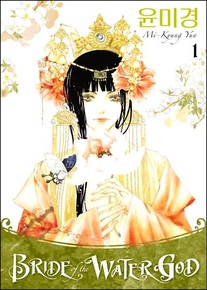Review
by Casey Brienza,Bride of the Water God
GN 1-2
| Synopsis: |  |
||
Years of drought has left Soah's village thirsty, starving, and feeling as if they have no other choice—they offer a bride to the Water God Habaek in order to appease him. Soah is elected to be that bridge. But instead of death by drowning, she finds herself transported to Suguk, Habaek's kingdom. There, she learns that her betrothed is just a little boy…or at least so he seems. As it turns out, Habaek is a child in appearance by day and a young man in appearance by night, and he tricks Soah into believing that his two incarnations are two different people. Soah, in spite of herself, starts harboring feelings for the “Mui” that she only seems to encounter at night. Even so, niggling questions remain: What happened to Habaek's first bride? And what is this about Soah having “two loves”…? |
|||
| Review: | |||
Bride of the Water God is Dark Horse's first ever licensed shoujo manga (or “sunjeong manhwa,” if we must be linguistically specific). And hopefully, it will not be the last; Mi-Kyung Yun's debut title is a strong work, and an excellent choice for American release. Rightfully acclaimed in her home country of Korea, Yun received a “Best New Artist” award in 2004. Two years later the public reaffirmed that vote with their own cold, hard cash: Bride of the Water God was 2006's top-selling sunjeong manhwa. Alas, the series is unlikely to repeat that success in the United States, if only because it will get lost in a flood of competing manga. But that does not, emphatically, make it any less of a must-see, and discriminating readers with a taste for fantasy-laced, shoujo romance will not be disappointed. Though “just” a baby-faced, rookie creator, Yun draws with a maturity beyond her years, and her art proves unexpectedly beautiful. Far more so, in fact, than a fast flip through the pages in front of the manga section of the bookstore would suggest. It has subtle grace, admittedly a rare visual commodity in manhwa, and utilizes empty space (black, white, and gray alike) as forcefully as intricate line work. Also, readers with a taste for Orientalism in their manga will delight in the profusion of reimagined period costumes and palaces. Billowing robes, long tresses, and gracefully swooping roofs are sure to captivate the reader. Exoticism gives what would otherwise be a pretty run of the mill, girl gets uber-hunk story added heft as well. Indeed, the historical fantasy setting probably seems only slightly less exotic and mythic to Korean readers than it does to American ones. This is in part because the manhwa seems to have borrowed a plot point or two from the famous Korean fairytale “Simchong, The Blind Man's Daughter.” Soah, like Simchong, is sacrificed to a water-related god to save her family and becomes his wife. After that, though, the similarities end, and the plot starts twisting into a mixture of love triangles and divine politicking with occasional, fast-aborted, attempts on Soah's life. Soah, for example, wonders if it is Mui (a.k.a. Habaek) or Habaek's loyal archer Huye that she feels most attracted to, while the Fire Goddess has been yearning for Habaek since she first met him (most likely a hopeless love since we all know that fire and water do not mix) and Habaek calls out for a Hakbin, his first human bride, when lying delirious in Soah's arms. And, to make matters worse, Habaek's mother has taken a keen interest in Soah, and Mother-in-Laws always spell trouble, right? These relationships develop slowly over the course of the first two volumes of Bride of the Water God. None of the characters and their motivations have been particularly well fleshed out yet, and thus far it is difficult to ascertain where and when the plot will pick up speed. For example, Mui at one point tells Soah to go home. The point of this command, however, is not to see what happens were she actually to do that but rather to see how she reacts to it. How about by not listening? How…exciting. By the end of the second volume, Soah still has not quite figured out that Habaek and Mui are the same person, but she has her suspicions. In order to confirm or deny those suspicions, she has decided to find out if the child Habaek has the same sinuous dragon tattoo on his chest as Mui. Which means, naturally, somehow finding an excuse to disrobe Habaek. This, rather amusingly, constitutes the cliffhanger that concludes volume two. While, granted, the manhwaga could be doing more with the story and the characters than she is, this series is nonetheless an attractive, compelling title a good step above a lot of the other dreck shelved near it in stores. Fans familiar with Korean publications will be pleased to note that Dark Horse's editions are the same A5 trim size as the originals and reproduce four pages per volume in lavish full color. All for a reasonable $9.95 list price, making Bride of the Water God good value for the money. |
| Grade: | |||
|
Overall : A-
Story : B+
Art : A
+ Gorgeous, romantic art and a compelling, fantasy-laced setting. |
|||
|
discuss this in the forum (13 posts) |
this article has been modified since it was originally posted; see change history |
|||
| Production Info: | ||
|
Full encyclopedia details about Release information about |
||